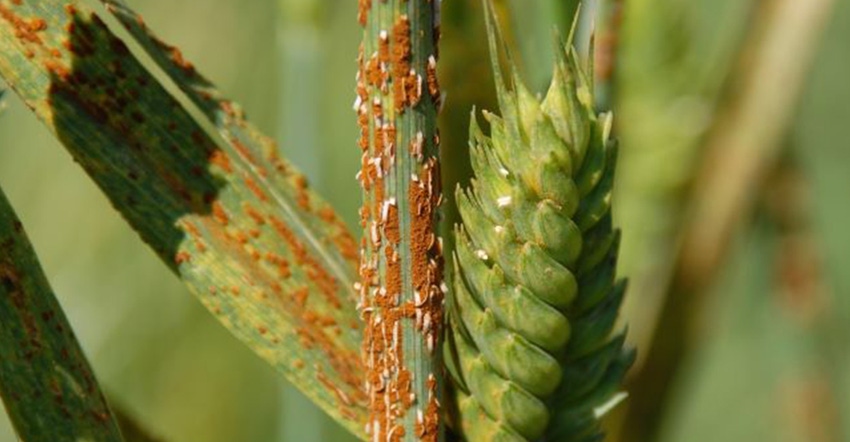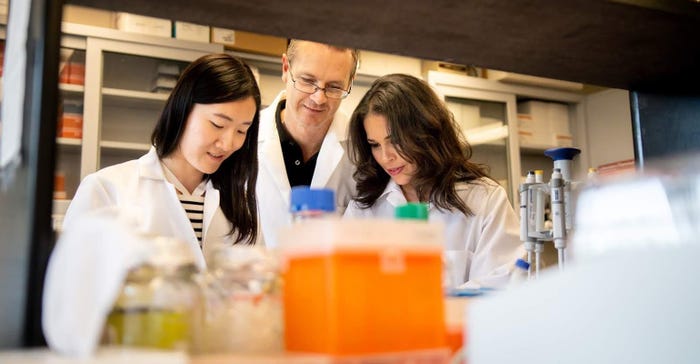November 15, 2019

Using genomic data, a team of scientists has determined how the deadly wheat stem rust Ug99 has spread so quickly and threatened global wheat supplies.
Scientists determined that Ug99’s ability to attack so many wheats can be traced to a rarely observed phenomenon where two different rust strains fuse together and exchange intact nuclei. This event creates a hybrid strain with a wider host range than its original parents.
Their work is the first to provide compelling genome-wide data that this event, called “somatic hybridization,” in the rust fungi can generate new virulence combinations. It also helps explain the sudden emergence of Ug99 in Africa two decades ago.
“Ug99 is an imminent threat to global food security due to its wide virulence and ability to readily spread across continents and oceans to infect distant wheat crops,” says Brian Steffenson, study co-author and plant pathology professor at the University of Minnesota College of Food Agricultural and Natural Resource Sciences. “We have known for a long time that the stem rust fungus is highly variable, but the molecular basis for this variation was not well understood. This study documents, at the genomic level, one important mechanism for how rust pathogens alter their virulence repertoire in nature.”
The discovery is detailed in a paper published Nov. 7 in the journal Nature Communications. The research team included scientists from U-M, the Commonwealth Scientific and Industrial Research Organization (CSIRO), Australian National University, and the University of the Free State in South Africa.
“This information will be critical for deciphering the genetic basis and evolution of rust virulence on wheat and for monitoring the global movements of the pathogen,” says Eva Henningsen, a U-M plant pathology graduate student.
By analyzing the DNA sequences of the two individual nuclei present in Ug99 and another more established African stem rust strain called Pgt21-0, researchers discovered that:
One of the two nuclei in Ug99 was nearly identical to one from Pgt21-0
The acquisition of this nucleus in Ug99 occurred after somatic fusion with another rust strain, possibly Pgt21-0, creating a unique hybrid that is even more virulent and dangerous to wheat than its parental strains
“As plant scientists, we’re always looking for an advantage over stem rust in order to develop more durably resistant crops,” says Feng Li, a U-M Ph.D. student and joint first author on the study. “The data obtained from this study will provide us with new insights on how Ug99 emerged to threaten wheat across the world.”
 PART OF A TEAM: Lead University of Minnesota scientists who elucidated the origin of a deadly strain of the wheat stem rust pathogen are Feng Li (left), U-M Ph.D. student and joint first author on the publication; Peter Dodds, CSIRO chief scientist/adjunct U-M professor and co-lead on the project; and Melania Figueroa, recently appointed group leader at CSIRO/former U-M associate professor and co-lead on the project.
PART OF A TEAM: Lead University of Minnesota scientists who elucidated the origin of a deadly strain of the wheat stem rust pathogen are Feng Li (left), U-M Ph.D. student and joint first author on the publication; Peter Dodds, CSIRO chief scientist/adjunct U-M professor and co-lead on the project; and Melania Figueroa, recently appointed group leader at CSIRO/former U-M associate professor and co-lead on the project.

Beside the practical implications of the study, researchers say they were surprised to learn that hybridization and a nucleus swap were the basis for the virulence shift in Ug99. These events were thought to be rare in nature.
“It was one of those amazing moments in science when you stop and think about how much there is still to learn about nature,” says former U-M professor Melania Figuera, group leader at CSIRO.
This research was supported by the 2Blades Foundation, USDA-Agriculture and Food Research Initiative, USDA-National Institute of Food and Agriculture, an ARC Future Fellowship, and the University of Minnesota Lieberman-Okinow Endowment.
Source: University of Minnesota, which is solely responsible for the information provided and is wholly owned by the source. Informa Business Media and all its subsidiaries are not responsible for any of the content contained in this information asset.
You May Also Like




